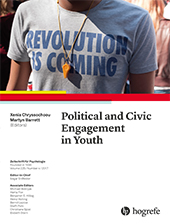Young People’s Engagement With the European Union
The Importance of Visions and Worries for the Future of Europe
Abstract
Abstract. This study investigated whether demographic variables, efficacy beliefs, visions, and worries are associated with four different forms of (dis)engagement with the European Union (EU): intended voting in the 2019 EU elections, nonconventional political engagement, psychological engagement, and the wish that one’s own country should leave the EU. The sample comprised 3,764 young people aged 16–25 years living in seven European countries: Albania, Austria, Germany, Italy, Romania, Spain, and the UK. Economic challenges, human rights, and the environment were the most important future visions; unemployment and poverty, climate change, civil unrests, and collapse of the EU were the most important future worries. The four forms of (dis)engagement with the EU were differentially associated with predictors, although internal efficacy and future vision of economic challenges predicted all forms. Implications for future EU policy are discussed.
References
(2015).
Predictors of civic and political participation among native and migrant youth in Italy: The role of organizational membership, sense of community, and perceived social well-being . In M. BarrettB. ZaniEds., Political and civic engagement. Multidisciplinary perspectives (pp. 268–291). London, UK: Routledge.(2012). How is civic engagement developed over time? Emerging answers from a multidisciplinary field. Journal of Adolescence, 35, 611–627. https://doi.org/10.1016/j.adolescence.2012.04.011
(2015).
Standby citizens: Understanding non-participation in contemporary democracies . In M. BarrettB. ZaniEds., Political and civic engagement. Multidisciplinary perspectives (pp. 96–108). London, UK: Routledge.(2000). Exercise of human agency through collective efficacy. Current Directions in Psychological Science, 9, 75–78. https://doi.org/10.1111/1467-8721.00064
(2015).
An integrative model of political and civic engagement: Linking the macro, social and psychological levels of explanation. Political and civic engagement: Theoretical understandings, evidence and policies . In M. BarrettB. ZaniEds., Political and civic engagement. Multidisciplinary perspectives (pp. 162–188). London, UK: Routledge.(2015a). Political and civic engagement. Multidisciplinary perspectives. London, UK: Routledge.
(2015b). Political and civic engagement: Theoretical understandings, evidence and policies. In M. BarrettB. Zani (Eds.), Political and civic engagement. Multidisciplinary perspectives (pp. 3–26). London, UK: Routledge.
(2014). When group memberships are negative: The concept, measurement, and behavioral implications of psychological disidentification. Self and Identity, 13, 294–321. https://doi.org/10.1080/15298868.2013.819991
(2015).
Political and civic participation: Findings from the modeling of existing data sets . In M. BarrettB. ZaniEds., Political and civic engagement. Multidisciplinary perspectives (pp. 195–212). London, UK: Routledge.(2009). Perceived political self-efficacy: Theory, assessment, and applications. European Journal of Social Psychology, 39, 1002–1020. https://doi.org/10.1002/ejsp.604
(2015).
Social and psychological factors influencing political and civic participation: A psychosocial perspective . In M. BarrettB. ZaniEds., Political and civic engagement. Multidisciplinary perspectives (pp. 124–145). London, UK: Routledge.(2012). Gender differences in youths’ political engagement and participation. The role of parents and of adolescents’ social and civic participation. Journal of Adolescence, 35, 561–575. https://doi.org/10.1016/j.adolescence.2011.10.002
(2016). Patterns of anxiety symptoms during adolescence: Gender differences and sociomotivational factors. Journal of Applied Developmental Psychology, 46, 41–50. https://doi.org/10.1016/j.appdev.2016.07.001
(2012). Attitudes toward political engagement and willingness to participate in politics: Trajectories throughout adolescence. Journal of Adolescence, 35, 485–495. https://doi.org/10.1016/j.adolescence.2011.07.002
(2012). Political participation and civic engagement: Towards a new typology. Human Affairs, 22, 283–300. https://doi.org/10.2478/s13374-012-0024-1
(2015).
Participation among youth, women and migrants: Findings from the Wallonia-Brussels Federation of Belgium . In M. BarrettB. ZaniEds., Political and civic engagement. Multidisciplinary perspectives (pp. 292–310). London, UK: Routledge.(2015).
Participation and integration: The contextual factors influencing minority and migrant participation . In M. BarrettB. ZaniEds., Political and civic engagement. Multidisciplinary perspectives (pp. 71–84). London, UK: Routledge.(2017). Accepting austerity or Grexit? Predicting acceptance of crisis solution strategies from people’s image of the Greece-EU relationship, their own position and norms of justice. International Review of Social Psychology, 30, 68–79. https://doi.org/10.5334/irsp.98
(2012). Does family experience influence political beliefs? Relation between interparental conflict perceptions and political efficacy in late adolescence. Journal of Adolescence, 35, 577–586. https://doi.org/10.1016/j.adolescence.2011.10.001
(2011). Dimensionality assessment of ordered polytomous items with parallel analysis. Psychological Methods, 16, 209–220. https://doi.org/10.1037/a0023353
(2012). Engaged citizens? Political participation and social engagement among youth, women, minorities and migrants. Human Affairs, 22, 273–282. https://doi.org/10.2478/s13374-012-0023-2



